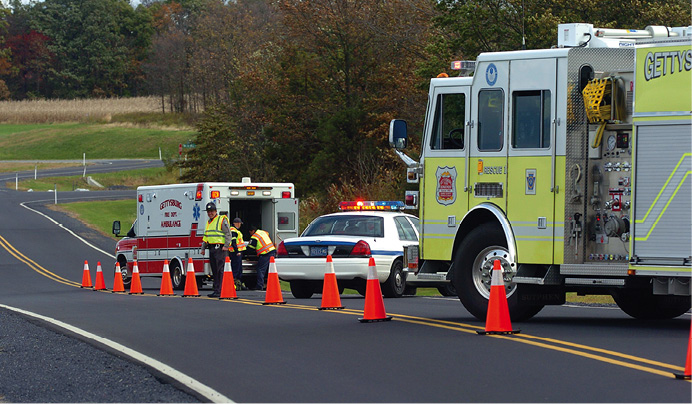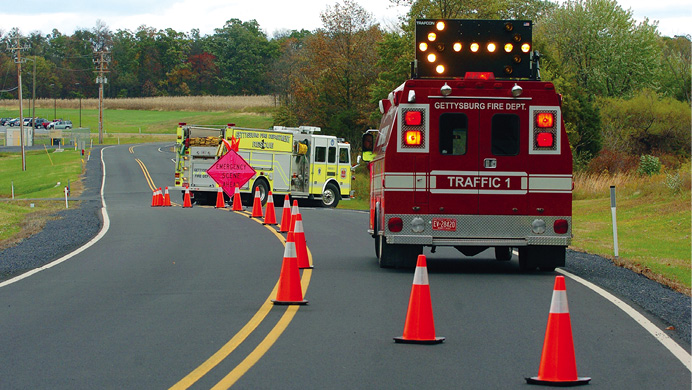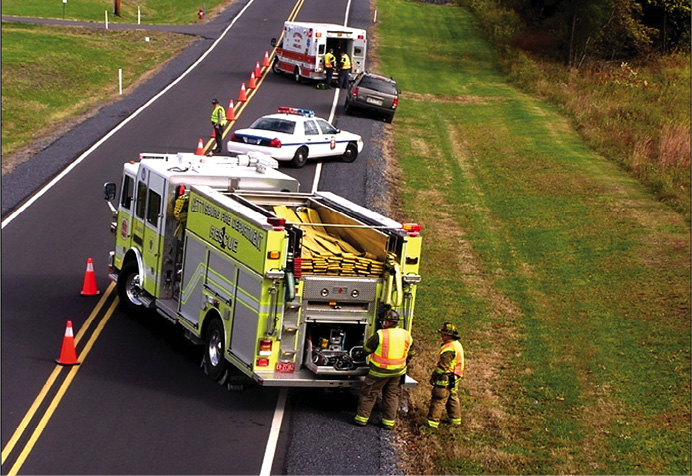The distribution of Federal Highway Administration (FHWA) Traffic Incident Management (TIM) training programs to all emergency responders has been going on for eight years now. By all accounts, more than a half million emergency personnel have completed the four-hour training program either in a classroom or through an online training program. Although many firefighters found the program useful, some attendees had a hard time relating to the material because they operate in a more rural environment where there are no high-speed, limited-access highways. Much of the content of the program is designed to address incidents that occur on interstate highways, freeways, and multilane state routes. The training material only touched on some aspects of handling roadway incidents in more rural environments.
Rural Challenges
I went to Alaska in 2013 to teach TIM Train-the-Trainer classes in Anchorage and Fairbanks. We had a mixed audience of firefighters, emergency medical technicians (EMTs), local police officers, state troopers, Department of Transportation (DOT) personnel, and some towing/recovery operators. Some things became clear early on in both classes.
Alaska does not have any interstate highways. Emergency services personnel in Alaska are used to traveling many miles to get to an incident; staffing across all disciplines was lower than what is typical in the lower 49 states. State troopers talked about “routine” three-hour response times for some traffic incidents because of the distance they must travel. Firefighters mentioned long wait times in some cases for law enforcement or DOT resources to arrive, especially when fatalities were involved.
As expected, the weather plays a significant role in dealing with emergency situations in the state, especially in the winter months. When I went to Fairbanks, it was -49°F when we landed, and hard-packed snow covered all roads.
Some of the challenges mentioned during the classes included situations common to rural areas in the lower 49 states.
- Areas serviced by volunteer fire departments can expect longer response times. Volunteer firefighters and EMTs often use personal vehicles to get to an emergency scene; it will take longer to get all the necessary emergency vehicles to the scene.
- Topography and inclement weather conditions present visibility challenges where incident scenes might not be readily apparent to approaching traffic because of curves, hills, high snow berms, fog, snow, or heavy rain.
- The “lane +1” blocking technique that is more common on multilane, high-speed highways is not practical on narrow, two-lane rural routes.
- The absence of roadway shoulders or the presence of deep ditches along some parts of roads can also present challenges when responding.
- For major incidents that require some time to resolve, rerouting traffic may require miles-long detours or may not be possible at all, leading to long lines of backed-up traffic; this will create additional issues for vehicle occupants who may be stranded for hours.
Although some attendees had difficulty relating to the training program as designed, it was apparent that some of the material was applicable to the rural environment and to the two-lane roads throughout the state.

(1) Photos courtesy of CVVFA/ResponderSafety.com.
RELATED FIREFIGHTER TRAINING
TIM and Firefighter Safety
Let’s review some of the strategies and tactics for TIM and protecting firefighters at roadway operations on rural roads.
- Local TIM committees can help facilitate collaboration, communication, cooperation, and training between the various regional response organizations. The committees can help develop a coordinated response plan for roadway incidents that clearly outlines various roles and responsibilities for each organization. TIM committees can facilitate multidiscipline training sessions so that people can develop working relationships before they meet each other at an incident scene. Committees can help formulate incident response plans for problem areas where incidents frequently occur.
- Follow the National Unified Goal for TIM, which calls for responder safety; safe, quick clearance of roadway incidents; and prompt, reliable, interoperable communications.
- Follow the “Control of Traffic Through Traffic Incident Management Areas” guidance, Chapter 6-I in the Manual of Uniform Traffic Control Devices (MUTCD) and any state supplement for your state. Equip fire apparatus with temporary traffic control devices such as road cones (orange and a minimum of 28 inches high; preferably 36 inches high), advance warning signs, and electronic or chemical flares and deploy them according to the guidelines in the MUTCD (photo 1). Note that cones that are 28 inches or higher should have two reflective bands per MUTCD guidelines instead of the one reflective band shown on the cones in photo 1.
- Follow “Traffic Incident Management” guidelines in National Fire Protection Association (NFPA) 1500, Standard on Fire Department Occupational Safety, Health, and Wellness Program.
- Use the incident command system and unified command structure for roadway incidents.
- Develop roadway incident response standard operating procedures (SOPs) and train personnel accordingly. Review the local SOPs annually with all personnel and revise or edit as necessary. According to NFPA 1500, all fire departments should train their personnel on roadway incident safety procedures.
- Personnel must wear high-visibility personal protective equipment when operating on roadways. Firefighters exposed to flame, heat, or hazardous materials should wear NFPA-compliant turnout gear. Protect the incident work area with a substantial blocking vehicle.
- Train, prepare, and equip personnel to handle manual traffic control procedures. Train personnel on using the proper hand signals to stop or direct traffic near an incident scene. Equip members assigned to traffic control with stop/slow paddles, flashlights, traffic wands, cones, and flares to slow traffic and guide motorists through a congested incident scene.
- Use large fire apparatus as blocking vehicles initially to create a safe work area at an incident scene. You might not be able to block “lane+1,” but you should be able to block any work area from approaching traffic where personnel are engaged in firefighting, extrication, or patient care. Be prepared to provide manual traffic control and direction so that you minimize the chance of a secondary crash near the original incident. In some cases, it might be necessary to block the whole road initially to address the initial incident. Know who to notify if you close the road, request additional support from other agencies as needed, and be sure to arrange for advance warning for drivers approaching the traffic backup (photo 2).

(2)
- Implement safe parking (or blocking or safe positioning) by turning steering wheels away from the work area, deploying chock blocks, and ensuring that personnel are aware of the “zero buffer” zone where personnel might come closest to moving traffic while working around blocking apparatus.
- Equip fire apparatus with high-visibility markings and use discretion with emergency warning lights, flood lights, and forward-facing white lights to avoid blinding drivers who might approach the incident area from any direction.
- Advance warning is especially critical in rural areas with reduced visibility because of weather or topography. Use emergency vehicles or warning signs well in advance of any backlog so that drivers can slow their approach or alter their route to avoid blocked roads. Digital alerting systems that provide travel information on navigation apps through smartphones or vehicle entertainment systems can be extremely helpful for advising motorists of incident scenes ahead. The first-arriving units may not know the exact location of an incident until they arrive on scene. In photo 3, the first unit on scene deployed an advance warning sign close to the incident. Ideally, advance warning signs should be located 250 feet or more upstream of an incident, depending on the rural road topography and line-of-sight conditions like curves, hills, fog, or other factors limiting visibility for approaching traffic.

(3)
Add additional traffic controls and deploy them farther upstream as additional units respond to the incident. An overview of the scene shows the good positioning of fire, police, and EMS vehicles and the proper cone deployment for this incident (photo 4).

(4)
- Communicate with the citizens in your community about how to react when driving around emergency incident scenes. Remind them to yield the right-of-way for responding emergency vehicles and coach them on how to react to parked emergency vehicles and personnel operating at an incident scene. Discourage the use of smartphones to take photos or video and remind people to watch where they are going, watch the traffic in front of them, and use caution and proceed slowly near the work area.
The current version of the National Traffic Incident Management Training Program might not address the rural roads environment in much detail, but the good news is that a project is underway right now to develop a version of the training program designed specifically for rural roads. It will take some time to develop that new program; meanwhile, there is much you can do to protect your personnel at incident scenes. Make sure that roadway incident operations and safety is one of your annual training programs.
Author’s Note: The following training program is free from the Responder Safety Learning Network: Traffic Incident Management on Rural Roads (https://bit.ly/3eTQQTJ).
Jack Sullivan, CSP, CFPS, is the director of training at the Emergency Responder Safety Institute, where he teaches Roadway Incident Safety & Survival Workshops for emergency responders. He is a subject matter expert on roadway incident operations and emergency personnel safety. Sullivan was a volunteer firefighter and chief officer for 23 years.

